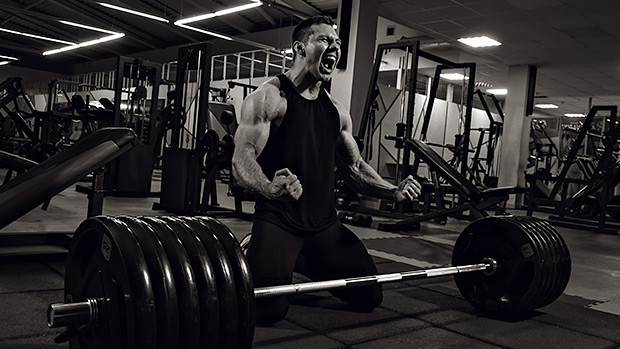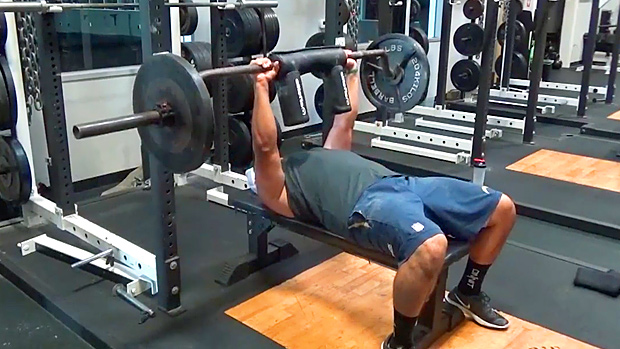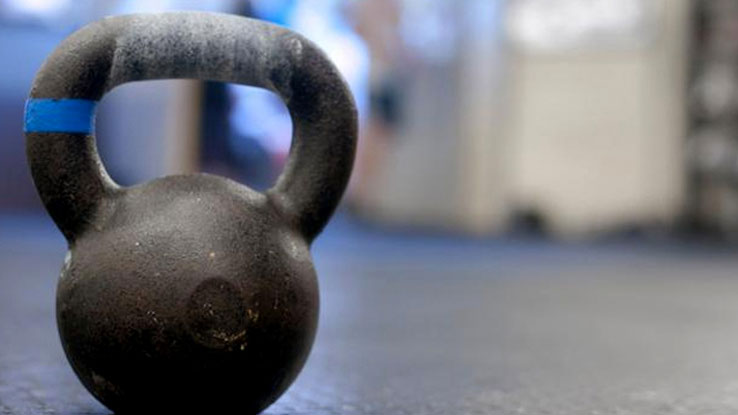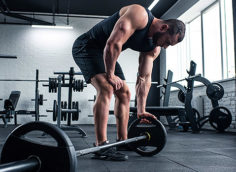The Functional Movement Patterns
Sports rely on specific movements for performance. Those actions are derivatives of the four main athletic movements and the four main lifting movements.
The four main athletic movements are jumping/landing, throwing/striking, locomotion, and rotation. But let's focus on what you can do in the weight room. The four main lifting movements are:
- Pushing
- Pulling
- Knee Bend
- Hip Hinge
This list of movement patterns should guide your training on a weekly basis.
Now sure, the term "functional" is a buzzword, but think of these differently. Functional exercises give you the ability to carry out what you need to do on a daily basis. Having a functional body is about having physical freedom. This means building an all-around stronger, more adaptable body capable of performing at a higher level in any environment... not just inside the gym.
That said, strength solves a lot of problems. It provides a better physical foundation to perform the four main athletic movements. So, a focus on the four main lifting movements is needed.
Every week do an exercise from each section. This will cover your bases. Since all exercises are merely variations of the main functional lifting movements, and since the categories they're in are general, then select (and deselect) from each category what you're capable of doing. Be discerning. Fit exercises to you; don't fit yourself to exercises.
Unless you're injured, perform at least one of the following lifts each week:
For Upper Body
- Vertical or Diagonal Pushing Lift
- Horizontal Pushing Lift
- Vertical Pulling Lift
- Horizontal Pulling Lift
For Lower Body
- Double-Leg Knee Bend Lift
- Single-Leg Knee Bend Lift
- Double-Leg Hip Hinge Lift
- Single-Leg Hip Hinge Lift
Let's get into these variations and the top three exercises in each category. And if you're training on the go, you'll also see the top versions you can do using just bodyweight and bands.
These exercises improve your ability to move something away from you like an object or opponent. These are the two specific types of pushing exercises you'll want to do each week: vertical or diagonal pushing, and horizontal pushing.
The Top 3 Vertical Pushing Exercises
1. One-Arm Dumbbell Overhead Press
Overhead pressing with one arm increases core activation. You're forced to maintain your torso position while dealing with the off-set load. There's also less of a tendency to cheat by leaning backward, the way you might during two-arm overhead presses.
2. Dumbbell Rotational Overhead Press
The rotation adds a little more coordination and control demand on both your shoulders and torso musculature. Plus, the foot pivot allows you to train some hip internal rotation, which is a key element to rotational power generation.
3. One-Arm Band Overhead Press
This is a great option when you're training with minimal equipment. You can increase the intensity by performing the reps fast, as shown in the video.
The Top 3 Diagonal Pushing Exercises
You don't have to do both a vertical and a diagonal pushing exercise each week, though doing both can make your workouts more complete. But if time is a factor, choose either a vertical or diagonal exercise. If overhead pressing bothers your shoulders, then stick with diagonal pressing until you get your shoulder issues worked out.
1. Dumbbell Incline Press
Incline presses train your pecs differently than horizontal pressing. Trainers often say "train movements, not muscles." Here's the reality: Muscles create movements.
Muscles, along with your bones and connective tissues, respond to how they're loaded. So, the only reason it's important to push from a variety of angles is because they train the muscles differently.
2. Angled Barbell Press
This is often called the landmine press. The landmine is really the name of a device (that you don't even need) used for this exercise. But you just need a barbell and a corner. Because of the offset nature, this exercise also really hits your core musculature.
3. Band Incline Press
No gym? No problem! Just pack some bands with you when you travel. And, even if you do have access to a gym, bands allow you to do dynamic effort (speed) work, as shown here.
The Top 3 Horizontal Pushing Exercises
When you do horizontal pushing exercises like bench presses, push-ups, etc., allow your elbows to go low enough to the point where you begin to feel a stretch in your pecs.
Why? Because training at longer (stretched) muscle lengths not only causes muscles to be stronger at long lengths, it can also improve flexibility just as well as static stretching (1, 2).
So the best way to prevent "tight" pecs is to do horizontal pressing exercises and other pec exercises in a way that creates some level of a stretch.
1. Barbell Bench Press
Every meathead has a love/love relationship with the bench press. So I made sure to include it here because the bench press, to many lifters, is like a baby and its ba-ba. If it's taken away, they start crying.
2. Dumbbell Bench Press
Some trainers believe that everyone should start with push-ups before moving on to the dumbbell press. I'm not one of them. My philosophy? Master your body with bodyweight training, and master your environment with external loads.
Dumbbell presses require you to control your arms individually because they're free to move. Push-ups anchor your arms to the ground and require you to control your torso position. Both exercises provide unique and complementary benefits.
3. Push-Up
Since there are many people who aren't yet capable of doing floor push-ups, and there are other advanced exercisers looking for ways to challenge their push-up ability, I've got a little something for everyone here.
Best Beginner Push-Up
These are better than incline push-ups for those who can't do floor push-ups on their own because these are band-assisted floor push-ups. And, they work perfectly with your strength curve.
I'm using an NT Loop band instead of a traditional latex band because I designed them to be a far more comfortable and stable band to place around your limbs, waist, or hips.
Advanced Band Resisted Push-Up
This setup is different than how it's usually done. Also, the NT Loop is much more comfortable than a conventional band.
Advanced Push-Up Challenge
Do the following three exercises back to back with no more than 30 seconds rest between exercises:
- Band-Resisted Push-Up x Max Reps
- Regular Push-Up x Max Reps
- Band-Assisted Push-Up x Max Reps
There are two specific types of pulling exercises you'll want to do weekly: vertical and horizontal. Here are my top three for each.
The Top 3 Vertical Pulling Exercises
1. Pull-Up and Chin-Up
It's good to switch up the grips you use. Go between neutral, overhand and underhand to change the muscle activation. You can use band or machine assistance if needed.
2. Lat Pulldown
Again, it's good to mix up grips between neutral, overhand, and underhand to change the muscle activation. That said, these "fighter's lat pulldowns" are a unique variation I developed years ago.
3. Banded Wide-Elbow Lat Pulldown
If you're training on the go, these pulldowns have the added benefit of hitting the mid-back, not just the lats. You do this by holding your arms like a Y at the top of each rep and like a W at the bottom. The goal is to keep your forearms parallel with the floor and your arms elevated towards the sky the entire time.
The Top 3 Horizontal Pulling Exercises
Some trainers claim that you should be able to horizontal pull double what you can horizontal push. They often talk of programing more horizontal pulling for this purpose. But this goes against the relevant scientific evidence and doesn't make sense from a biomechanics perspective. (I covered this in 6 New Rules For Rows.)
1. Dumbbell Bent-Over Row
Barbell rows are fine, I just prefer dumbbell rows because they give you more freedom to rotate your hands/wrists into a more neutral position.
2. Dumbbell Off-Bench Row
Keep both feet on the ground. This allows you to control your position better than what you'd be able to with one leg on the bench. Don't cheat by rotating your torso toward the sky as you row. Keep your shoulders fairly level with the floor.
3. Cable or Band One-Arm Row
Using bands are the option when you don't have access to a gym. But both the cable and band version are also great for folks who can't seem to avoid having a hunch back when they bend over to perform the two rowing variations above. Keeping an upright torso also trains your lumbar extensors to maintain your torso position against the band or cable pulling your over.
Many trainers have squatting as its own movement category. There's a specific reason I don't do that: it can become a problem.
When we think of squats, we usually think of how you move when you do a barbell squat. When we assume this type of squat represents a foundational human action that everyone should be able to do, we try to fit square pegs into round holes. And not everyone is built to squat in that manner.
However, when we realize that the conventional style of squatting is just one way to train the fundamental action of knee bending, we don't put it on a pedestal. We know there are plenty of other ways to do knee bending exercises that better fit the individual based on their proportions and injury history.
This is why it's ridiculous when trainers say, "You just don't know how to coach these movements," as if everyone can be coached out of their individual skeletal framework, body proportions, and injury history. This is a glaring example of trainers who are trying to fit people to exercises instead of fitting exercises to people.
Anyway, there are two types of knee-bends to do each week: double leg and single leg.
The Top 3 Double-Leg Knee Bend Exercises
1. Barbell Squat
Lift double your bodyweight. Find a stance that's comfortable for you and allows you to hold your spine strong and prevent your knees from caving in.
2. Trap Bar Squat
Although some people refer to this as a deadlift rather than a squat, the torso and hip position more closely resemble those of a barbell squat than a deadlift. That said, the exercise can also be done with slightly less knee bend and a more forward torso position, resembling the deadlift. That version is what I call a trap-bar deadlift.
3. Band Squat or Squat Jump
If you're training on the go, band squats are awesome because they create accommodating resistance. And, the NT Loop is far more comfortable around the neck and shoulders. You can step up the challenge by trying these using the 1.5 method.
If you're more advanced, squat jumps are just what the doctor ordered when you're training with minimal equipment. And, if you're looking for a serious challenge, try this high-volume complex that combines band squats and squat jumps.
Do the following three exercises back to back:
- Band 1.5 Squat x 10 reps
- Band Speed Squat (go to parallel) x 20 reps
- Squat Jump x 10 reps
When doing the squat jumps, take off like a cannon and land like a butterfly.
The Top 3 Single-Leg Knee Bend Exercises
There are three types of single leg exercises: one-leg stance, split-stance, and lunging and stepping. Single-leg exercises don't have to mean only one leg is working at a time. It can also mean both legs are working while one leg is doing most of the work, like when you push a sled, which demands your lead leg gets most of the work on each step.
1. Knee Tap Squat
Lean forward a bit and hold your non-weight-bearing foot behind you instead of in front of you the way you would during a pistol squat. This version of the single-leg squat puts you in position that's more common to how we move in life and sport, which is why it feels more natural.
2. Elevated Reverse Lunge
Use a platform (which increases the range of motion) that's low enough to allow you to touch your back knee to the floor on each rep. If a reduction in range is needed, you can do it without the platform.
You can also add a band around the top of your shin, just below your knee joint, that's pulling your shin forwards to further increase the quadriceps demand at the top of the range of motion.
3. Sled Pushes or Drags
The sled is the most misunderstood and underutilized tool in gym because it's usually reserved for conditioning. But it's a great single-leg movement if you load it heavier.
It's especially valuable for those who have knee problems and those who have back trouble. Athletes can move heavy loads on the sled with no added stress on their painful areas.
Hip hinge exercises are to the lower body what pulling exercises are to the upper body. Like knee bends, hip hinge exercises come in two forms and it's smart to do both weekly: double and single leg.
The debate about single-leg versus double-leg exercise is like arguing about whether you should eat only carrots or only broccoli. In reality, each vegetable offers a unique flavor and provides a certain set of nutrients, so just include them both in your diet!
The double-leg exercises in both sections place you in a wider base of support and force you to use both your legs and your hips together to coordinate many muscles to move big loads, which is metabolically taxing.
In contrast, unilateral leg training forces you into a narrow base of support, which works your legs and hips in a slightly different manner – one that's often closer to how your legs work during sports since many athletic actions (like running and cutting) are single-leg dominant. Of course, they also force you to focus on controlling and using one side at a time, which is great for strengthening your weaker, less-coordinated side.
Since both unilateral and bilateral leg training help you improve muscle and strength – and since both offer unique, complementary benefits – it makes sense to do both in your lower-body workouts to make them more well-rounded and effective.
The Top 3 Double-Leg Hip Hinge Exercises
1. Barbell Hybrid Deadlift
This lift combines the Romanian and sumo deadlift, which you'd do with a wider stance and a more upright torso. For many, the hybrid deadlift is a smart substitute for traditional deadlifts for two reasons.
First, the wider stance is easier and more natural for most lifters to do while maintaining the alignment cues. Second, this starting position keeps the barbell closer to the hips than the conventional style, which provides a shorter lever arm. This gives you a greater mechanical advantage while placing less overall stress on the lower back.
2. Romanian Deadlift (RDL)
Lifters often make the mistake of creating excess extension in the lower back when doing the RDL. This reduces hip extension. Not good. With a barbell, drive your hips toward the barbell as you raise the bar and stand tall without overextending your lower back. Remember, it's a hip hinge movement – the extension should come from the hips, not the lower back.
3. Double Band Good Morning
This is an awesome exercise you can do while traveling. You just need two bands. Place the horizontal band below your hips so it stays in place and forces your to use your glutes more to push against it at the top of each rep.
Hold as low as needed to create appropriate resistance. It's what gives you resistance at the bottom and accommodating resistance at the top. At the very top, the band around your hips forces your glutes to work harder, increasing glute activation.
The Top 3 Single-Leg Hip Hinge Exercises
1. Dumbbell Traveling RDL Lunge
There's a big eccentric strength demand on your glutes and hamstrings to decelerate your torso and the dumbbells on each step. And you've got to use your glutes and hams to propel you forward on each rep.
2. Angled Barbell Leaning RDL
This Romanian deadlift variation hits the glutes and improves athleticism. It's not only great for booty-building, but also for improving change-of-direction ability in athletes.
3. Band Thigh-Resisted RDL
Place the band around one thigh to focus the resistance on one side of your booty at a time. You'll feel it at the top of each rep. This is another great exercise for both increasing glute gains and performance.
If you're training on the go, you'd just do this without the dumbbell and go for more reps.





